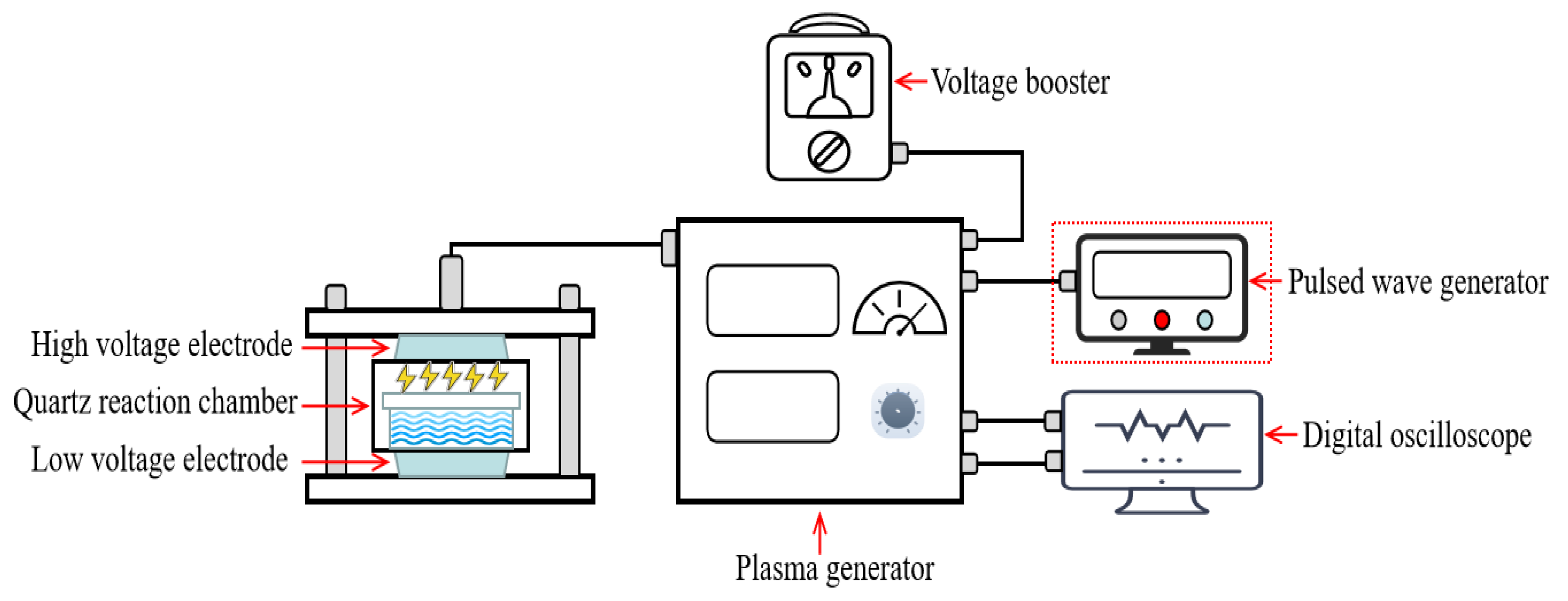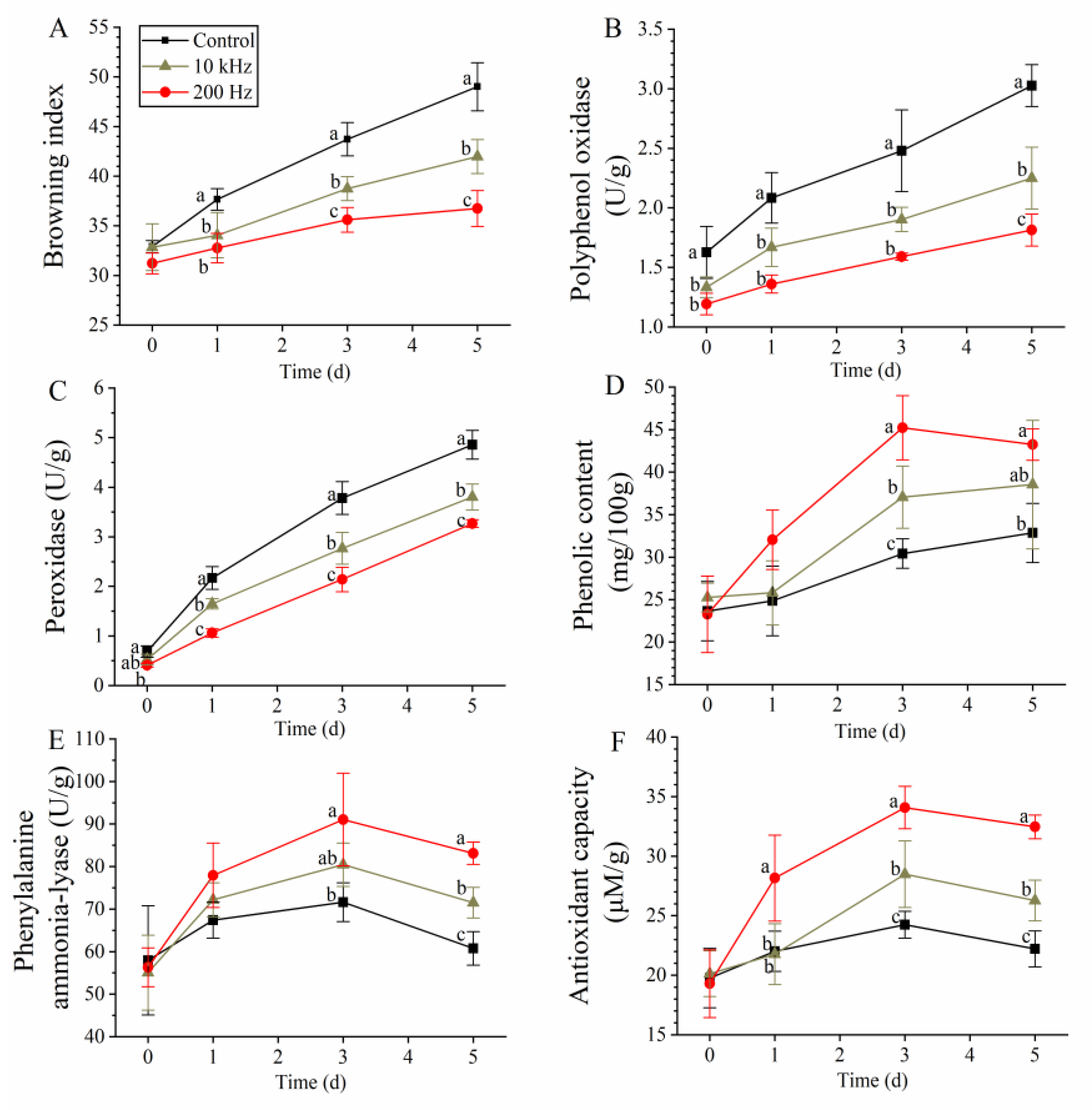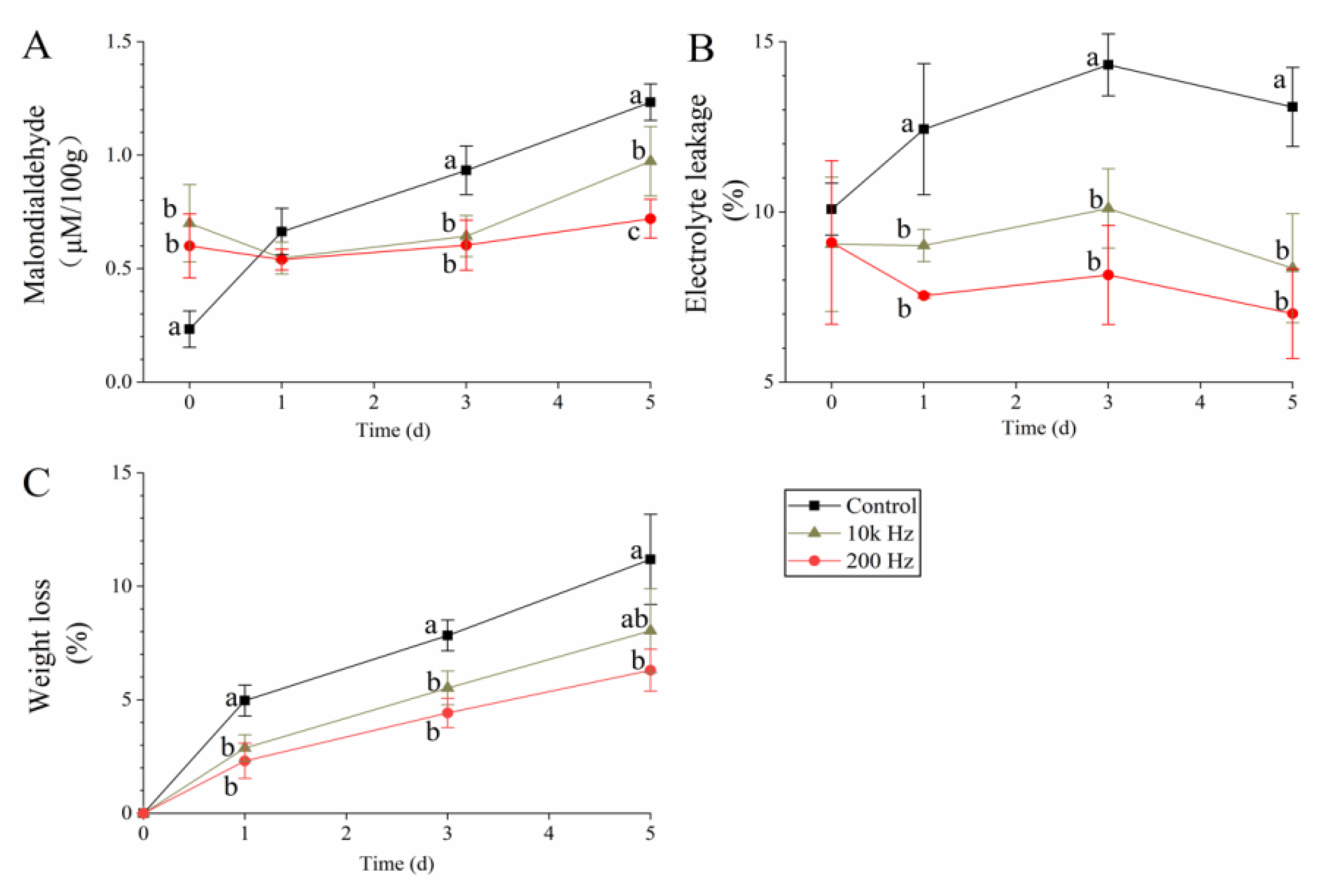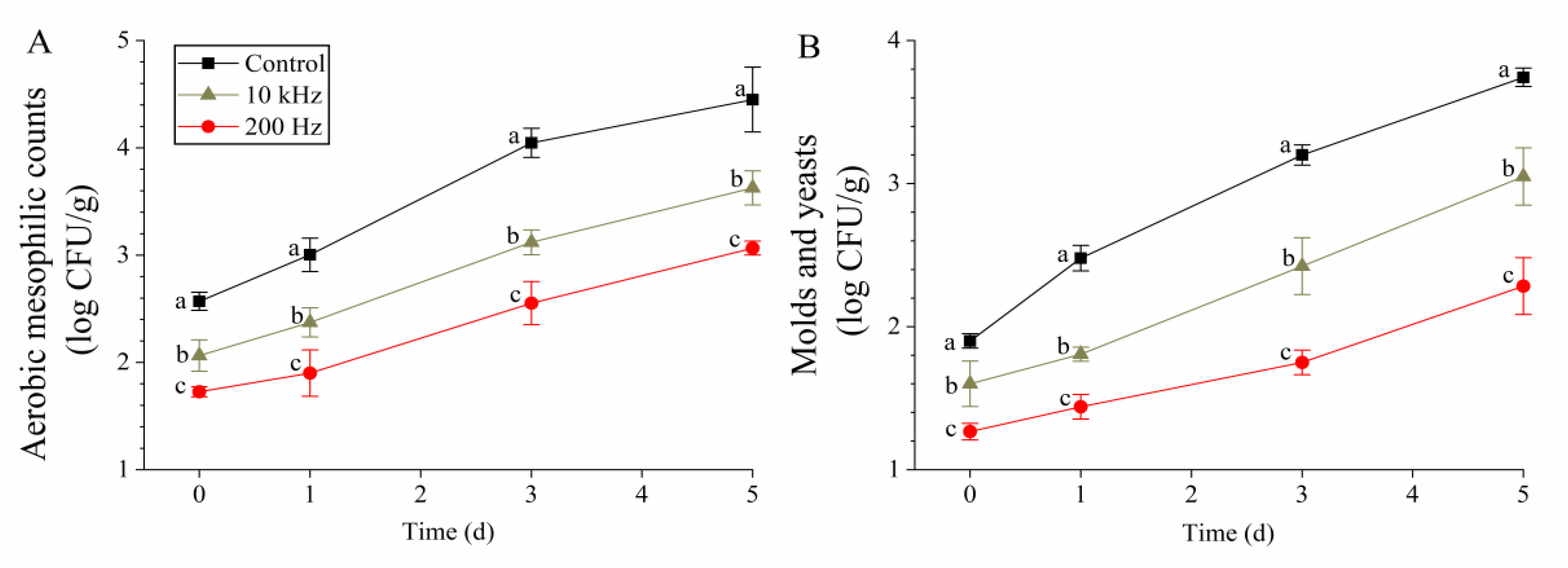Processing of Fresh-Cut Potato Using Plasma-Activated Water Prepared by Decreasing Discharge Frequency
Abstract
:1. Introduction
2. Materials and Methods
2.1. Sample Preparation
2.2. PAW Generation and Sample Treatment
2.3. Analysis of PAW Properties
2.4. Browning Index Analysis
2.5. Weight Loss and Electrolyte Leakage Analysis
2.6. Liquid Nitrogen Grinding
2.7. PPO, POD, and PAL Analyses
2.8. Phenolic Content and Antioxidant Capacity Analyses
2.9. Malondialdehyde Analysis
2.10. Microbiological Analysis
2.11. Statistical Analysis
3. Results and Discussion
3.1. PAW Properties
3.2. Effects on Color and Browning-Related Enzymes
3.3. Effects on Antioxidant Capacity
3.4. MDA, Membrane Permeability, and Weight Loss
3.5. Effects on Microbial Counts
4. Conclusions
Supplementary Materials
Author Contributions
Funding
Data Availability Statement
Conflicts of Interest
References
- Wang, D.; Chen, L.; Ma, Y.; Zhang, M.; Zhao, Y.; Zhao, X. Effect of UV-C treatment on the quality of fresh-cut lotus (Nelumbo nucifera Gaertn.) root. Food Chem. 2019, 278, 659–664. [Google Scholar] [CrossRef] [PubMed]
- Han, C.; Zhen, W.; Chen, Q.; Fu, M. UV-C irradiation inhibits surface discoloration and delays quality degradation of fresh-cut stem lettuce. LWT Food Sci. Technol. 2021, 147, 111533. [Google Scholar] [CrossRef]
- Zhao, X.; Guo, S.; Ma, Y.; Zhao, W.; Wang, P.; Zhao, S.; Wang, D. Ascorbic acid prevents yellowing of fresh-cut yam by regulating pigment biosynthesis and energy metabolism. Food Res. Int. 2022, 157, 111424. [Google Scholar] [CrossRef] [PubMed]
- Xu, D.; Chen, C.; Zhou, F.; Liu, C.; Tian, M.; Zeng, X.; Jiang, A. Vacuum packaging and ascorbic acid synergistically maintain the quality and flavor of fresh-cut potatoes. LWT Food. Sci. Technol. 2022, 162, 113356. [Google Scholar] [CrossRef]
- Xu, Y.; Wang, D.; Zhao, W.; Zheng, Y.; Wang, Y.; Wang, P.; Ma, Y.; Zhao, X. Low frequency ultrasound treatment enhances antibrowning effect of ascorbic acid in fresh-cut potato slices. Food Chem. 2022, 380, 132190. [Google Scholar] [CrossRef]
- Zhao, Y.M.; Patange, A.; Sun, D.W.; Tiwari, B. Plasma-activated water: Physicochemical properties, microbial inactivation mechanisms, factors influencing antimicrobial effectiveness, and applications in the food industry. Compr. Rev. Food Sci. Food Saf. 2020, 19, 3951–3979. [Google Scholar] [CrossRef]
- Xiang, Q.; Fan, L.; Li, Y.; Dong, S.; Li, K.; Bai, Y. A review on recent advances in plasma-activated water for food safety: Current applications and future trends. Crit. Rev. Food Sci. Nutr. 2022, 62, 2250–2268. [Google Scholar] [CrossRef]
- Perinban, S.; Orsat, V.; Lyew, D.; Raghavan, V. Effect of plasma activated water on Escherichia coli disinfection and quality of kale and spinach. Food Chem. 2022, 397, 133793. [Google Scholar] [CrossRef]
- Laurita, R.; Gozzi, G.; Tappi, S.; Capelli, F.; Bisag, A.; Laghi, G.; Gherardi, M.; Cellini, B.; Abouelenein, D.; Vittori, S.; et al. Effect of plasma activated water (PAW) on rocket leaves decontamination and nutritional value. Innov. Food Sci. Emerg. Technol. 2021, 73, 102805. [Google Scholar] [CrossRef]
- Liu, X.; Li, Y.; Wang, S.; Huangfu, L.; Zhang, M.; Xiang, Q. Synergistic antimicrobial activity of plasma-activated water and propylparaben: Mechanism and applications for fresh produce sanitation. LWT Food. Sci. Technol. 2021, 146, 111447. [Google Scholar] [CrossRef]
- Perinban, S.; Orsat, V.; Raghavan, V. Influence of plasma activated water treatment on enzyme activity and quality of fresh-cut apples. Food Chem. 2022, 393, 133421. [Google Scholar] [CrossRef]
- Wang, J.; Wang, S.; Sun, Y.; Li, C.; Li, Y.; Zhang, Q.; Wu, Z. Reduction of Escherichia coli O157:H7 and naturally present microbes on fresh-cut lettuce using lactic acid and aqueous ozone. RSC Adv. 2019, 9, 22636–22643. [Google Scholar] [CrossRef] [Green Version]
- Wang, J.; Huang, K.; Wu, Z.; Yu, Y. Effects of ultrasound-assisted low-concentration chlorine washing on ready-to-eat winter jujube (Zizyphus jujuba Mill. cv. Dongzao): Cross-contamination prevention, decontamination efficacy, and fruit quality. Ultrason. Sonochem. 2022, 82, 105905. [Google Scholar] [CrossRef]
- Wen, B.; Cui, S.; Suo, X.; Supapvanich, S. Stress response of fresh-cut potatoes to laser irradiation before processing can prevent discoloration and maintain overall quality. Postharvest Biol. Technol. 2023, 197, 112213. [Google Scholar] [CrossRef]
- Liu, X.; Yang, Q.; Lu, Y.; Li, Y.; Li, T.; Zhou, B.; Qiao, L. Effect of purslane (Portulaca oleracea L.) extract on anti-browning of fresh-cut potato slices during storage. Food Chem. 2019, 283, 445–453. [Google Scholar] [CrossRef]
- Wang, J.; Wu, Z.; Wang, H. Combination of ultrasound-peracetic acid washing and ultrasound-assisted aerosolized ascorbic acid: A novel rinsing-free disinfection method that improves the antibacterial and antioxidant activities in cherry tomato. Ultrason. Sonochem. 2022, 86, 106001. [Google Scholar] [CrossRef]
- Beltrán, D.; Selma, M.V.; Tudela, J.A.; Gil, M.I. Effect of different sanitizers on microbial and sensory quality of fresh-cut potato strips stored under modified atmosphere or vacuum packaging. Postharvest Biol. Technol. 2005, 37, 37–46. [Google Scholar] [CrossRef]
- Peng, L.; Yang, S.; Li, Q.; Jiang, Y.; Joyce, D.C. Hydrogen peroxide treatments inhibit the browning of fresh-cut Chinese water chestnut. Postharvest Biol. Technol. 2008, 47, 260–266. [Google Scholar] [CrossRef]
- Chumyam, A.; Faiyue, B.; Saengnil, K. Reduction of enzymatic browning of fresh-cut guava fruit by exogenous hydrogen peroxide-activated peroxiredoxin/thioredoxin system. Sci. Hortic. 2019, 255, 260–268. [Google Scholar] [CrossRef]
- Chen, C.; Hu, W.; He, Y.; Jiang, A.; Zhang, R. Effect of citric acid combined with UV-C on the quality of fresh-cut apples. Postharvest Biol. Technol. 2016, 111, 126–131. [Google Scholar] [CrossRef]
- Patra, A.; Prasath, V.A.; Pandiselvam, R.; Sutar, P.P.; Jeevarathinam, G. Effect of Plasma activated water (PAW) on physicochemical and functional properties of foods. Food Control 2022, 142, 109268. [Google Scholar] [CrossRef]
- Zhang, J.; Sun, X. Recent advances in polyphenol oxidase-mediated plant stress responses. Phytochemistry 2021, 181, 112588. [Google Scholar] [CrossRef] [PubMed]
- Zhu, Y.; Du, X.; Zheng, J.; Wang, T.; You, X.; Liu, H.; Liu, X. The effect of ultrasonic on reducing anti-browning minimum effective concentration of purslane extract on fresh-cut potato slices during storage. Food Chem. 2021, 343, 128401. [Google Scholar] [CrossRef] [PubMed]
- Calder, B.L.; Skonberg, D.I.; Davis-Dentici, K.; Hughes, B.H.; Bolton, J.C. The effectiveness of ozone and acidulant treatments in extending the refrigerated shelf life of fresh-cut potatoes. J. Food Sci. 2011, 76, S492–S498. [Google Scholar] [CrossRef] [PubMed]
- Rico, D.; Martín-Diana, A.B.; Frías, J.M.; Henehan, G.T.M.; Barry-Ryan, C. Effect of ozone and calcium lactate treatments on browning and texture properties of fresh-cut lettuce. J. Sci. Food Agric. 2006, 86, 2179–2188. [Google Scholar] [CrossRef]
- Zhang, L.; Lu, Z.; Yu, Z.; Gao, X. Preservation of fresh-cut celery by treatment of ozonated water. Food Control 2005, 16, 279–283. [Google Scholar] [CrossRef]
- Duangmal, K.; Apenten, R.K.O. A comparative study of polyphenoloxidases from taro (Colocasia esculenta) and potato (Solanum tuberosum var. Romano). Food Chem. 1999, 64, 351–359. [Google Scholar] [CrossRef]
- Qiao, L.; Gao, M.; Zheng, J.; Zhang, J.; Lu, L.; Liu, X. Novel browning alleviation technology for fresh-cut products: Preservation effect of the combination of Sonchus oleraceus L. extract and ultrasound in fresh-cut potatoes. Food Chem. 2021, 348, 129132. [Google Scholar] [CrossRef]
- Yu, J.; Zhang, F.; Zhang, J.; Han, Q.; Song, L.; Meng, X. Effect of photodynamic treatments on quality and antioxidant properties of fresh-cut potatoes. Food Chem. 2021, 362, 130224. [Google Scholar] [CrossRef]
- Christopoulos, M.V.; Tsantili, E. Participation of phenylalanine ammonia-lyase (PAL) in increased phenolic compounds in fresh cold stressed walnut (Juglans regia L.) kernels. Postharvest Biol. Technol. 2015, 104, 17–25. [Google Scholar] [CrossRef]
- Sun, Y.; Wu, Z.; Zhang, Y.; Wang, J. Use of aqueous ozone rinsing to improve the disinfection efficacy and shorten the processing time of ultrasound-assisted washing of fresh produce. Ultrason. Sonochem. 2022, 83, 105931. [Google Scholar] [CrossRef]
- Li, Y.; Han, L.; Wang, B.; Zhang, J.; Nie, J. Dynamic degradation of penconazole and its effect on antioxidant enzyme activity and malondialdehyde content in apple fruit. Sci. Hortic. 2022, 300, 111053. [Google Scholar] [CrossRef]
- Fan, X.; Sokorai, K.J.; Niemira, B.A.; Mills, R.S.; Zhen, M.Y. Quality of gamma ray-irradiated iceberg lettuce and treatments to minimize irradiation-induced disorders. HortScience 2012, 47, 1108–1112. [Google Scholar] [CrossRef] [Green Version]
- Salgado, S.P.; Pearlstein, A.J.; Luo, Y.; Feng, H. Quality of Iceberg (Lactuca sativa L.) and Romaine (L. sativa L. var. longifolial) lettuce treated by combinations of sanitizer, surfactant, and ultrasound. LWT Food Sci. Technol. 2014, 56, 261–268. [Google Scholar] [CrossRef]
- Ketteringham, L.; Gausseres, R.; James, S.J.; James, C. Application of aqueous ozone for treating pre-cut green peppers (Capsicum annuum L.). J. Food Eng. 2006, 76, 104–111. [Google Scholar] [CrossRef]
- Van Haute, S.; Tryland, I.; Veys, A.; Sampers, I. Wash water disinfection of a full-scale leafy vegetables washing process with hydrogen peroxide and the use of a commercial metal ion mixture to improve disinfection efficiency. Food Control 2015, 50, 173–183. [Google Scholar] [CrossRef] [Green Version]




| Parameter | Discharge Frequency (Hz) | |
|---|---|---|
| 10 k | 200 | |
| pH | 3.42 ± 0.19 | 2.64 ± 0.05 |
| Temperature (°C) | 23.80 ± 1.84 | 31.30 ± 0.75 |
| ORP (mV) | 461.67 ± 18.18 | 547.33 ± 9.02 |
| Conductivity (μs/cm) | 182.67 ± 16.80 | 883.33 ± 37.21 |
| Ozone (mg/L) | 1.21 ± 0.24 | 6.05 ± 0.73 |
| Hydrogen peroxide (μM) | 181.67 ± 40.41 | 658.33 ± 28.87 |
| Nitrate (mg/L) | 4.03 ± 0.19 | 32.45 ± 5.43 |
| Nitrite (mg/L) | 0.31 ± 0.04 | 0.46 ± 0.08 |
Disclaimer/Publisher’s Note: The statements, opinions and data contained in all publications are solely those of the individual author(s) and contributor(s) and not of MDPI and/or the editor(s). MDPI and/or the editor(s) disclaim responsibility for any injury to people or property resulting from any ideas, methods, instructions or products referred to in the content. |
© 2023 by the authors. Licensee MDPI, Basel, Switzerland. This article is an open access article distributed under the terms and conditions of the Creative Commons Attribution (CC BY) license (https://creativecommons.org/licenses/by/4.0/).
Share and Cite
Aihaiti, A.; Maimaitiyiming, R.; Wang, L.; Wang, J. Processing of Fresh-Cut Potato Using Plasma-Activated Water Prepared by Decreasing Discharge Frequency. Foods 2023, 12, 2285. https://doi.org/10.3390/foods12122285
Aihaiti A, Maimaitiyiming R, Wang L, Wang J. Processing of Fresh-Cut Potato Using Plasma-Activated Water Prepared by Decreasing Discharge Frequency. Foods. 2023; 12(12):2285. https://doi.org/10.3390/foods12122285
Chicago/Turabian StyleAihaiti, Aihemaitijiang, Ruxianguli Maimaitiyiming, Liang Wang, and Jiayi Wang. 2023. "Processing of Fresh-Cut Potato Using Plasma-Activated Water Prepared by Decreasing Discharge Frequency" Foods 12, no. 12: 2285. https://doi.org/10.3390/foods12122285
APA StyleAihaiti, A., Maimaitiyiming, R., Wang, L., & Wang, J. (2023). Processing of Fresh-Cut Potato Using Plasma-Activated Water Prepared by Decreasing Discharge Frequency. Foods, 12(12), 2285. https://doi.org/10.3390/foods12122285





